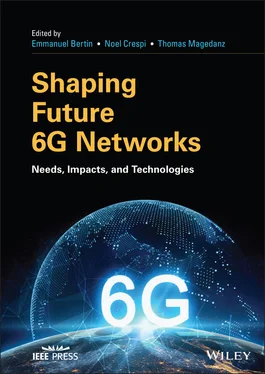Shaping Future 6G Networks
Здесь есть возможность читать онлайн «Shaping Future 6G Networks» — ознакомительный отрывок электронной книги совершенно бесплатно, а после прочтения отрывка купить полную версию. В некоторых случаях можно слушать аудио, скачать через торрент в формате fb2 и присутствует краткое содержание. Жанр: unrecognised, на английском языке. Описание произведения, (предисловие) а так же отзывы посетителей доступны на портале библиотеки ЛибКат.
- Название:Shaping Future 6G Networks
- Автор:
- Жанр:
- Год:неизвестен
- ISBN:нет данных
- Рейтинг книги:3 / 5. Голосов: 1
-
Избранное:Добавить в избранное
- Отзывы:
-
Ваша оценка:
- 60
- 1
- 2
- 3
- 4
- 5
Shaping Future 6G Networks: краткое содержание, описание и аннотация
Предлагаем к чтению аннотацию, описание, краткое содержание или предисловие (зависит от того, что написал сам автор книги «Shaping Future 6G Networks»). Если вы не нашли необходимую информацию о книге — напишите в комментариях, мы постараемся отыскать её.
Discover the societal and technology drivers contributing to build the next generation of wireless telecommunication networks Shaping Future 6G Networks: Needs, Impacts, and Technologies
Shaping Future 6G Networks
Shaping Future 6G Networks — читать онлайн ознакомительный отрывок
Ниже представлен текст книги, разбитый по страницам. Система сохранения места последней прочитанной страницы, позволяет с удобством читать онлайн бесплатно книгу «Shaping Future 6G Networks», без необходимости каждый раз заново искать на чём Вы остановились. Поставьте закладку, и сможете в любой момент перейти на страницу, на которой закончили чтение.
Интервал:
Закладка:
In these scenarios, the role of the network is to provide a high‐throughput, low‐latency bit pipe to connect the sensors on the physical product with the computing platforms on which the digital twin is hosted. Several elements contribute to the need for ultrahigh throughput, which would not be supported by 5G technologies, as for the teleportation use case of Section 2.3.2. A digital twin will be generated by a large number of data sources, which need to be distributed around the physical device, and capture different properties, not only the visual aspect. Moreover, the twinning rate, i.e. the rate at which the physical and digital representations are synchronized, could be in the order of hundreds of Hertz, for applications that require a real‐time tracking of the evolution of the physical object. Therefore, the data rate required by digital twin use cases can be in the order of tens of gigabits per second, with the need for high‐capacity links between the different components of a digital twin system (sensors to database, and database to representation). Similarly, when real‐time interaction and control of the physical object through its digital counterpart is required, the latency should be in the sub‐millisecond range. However, if real‐time control is not of interest, or a lower level of fidelity can be accepted, digital twinning applications can tolerate higher latencies and lower throughput. Therefore, 6G networks should also focus on adaptability and openness to the applications, with open interfaces to enable cooperation between the wireless stack and the higher layers, for example, to optimize the number of sources and the twinning rate according to the capabilities of the network, or, vice versa, to allocate more resources according to the needs of the application.
2.3.4 Smart Transportation
The support of communications in smart transportation is threefold: infotainment, automated driving (AD), and Cooperative Intelligent Transport Systems (C‐ITS). Infotainment (sometimes referred to as navitainment ) comprises information, navigation, and entertainment services for drivers and passengers. These services are expected to evolve into extended reality (XR) experiences for passengers and enhanced high‐definition (HD) maps and real‐time information services for drivers, and industry players will need to collaborate in order to satisfy the demand for different in‐vehicle services. AD will experience a gradual increase in capabilities and market share. It is expected that up to 15% of the new vehicles sold in 2030 will have AD in designated conditions and, while the personal vehicle market is also expected to grow, trucks and delivery vehicles have a stronger business incentive compared to personal vehicles, which will drive faster deployment once technology is available [4]. AD requires high volumes of data to be exchanged between cars and the cloud for HD 3D maps, sensor sharing, and computational offloading. Those are the aspects related to individual vehicles, but the goal of C‐ITS is to improve safety and comfort by exchanging information between vehicles and the road infrastructure. Real‐time information will include not only measurements and status from sensors but also path planning and cooperative maneuvers, that are particularly relevant for unmanned aerial vehicles. An important consideration is vulnerable road users (VRUs) such as pedestrians, cyclists, and road workers that can be increasingly protected with solutions based on positions and path crossing alerts enabled by the communication between smartphones (or other personal devices) and vehicles. The former aspects are mostly related to the mobility safety and experience but, in the future, other use cases such as preemptive logistics, fleet management, and telematics will expand and have a key role in society. These services are expected to be implemented by global players in the coming years and, even if they have less stringent requirements on data rate and latency, network coverage and secure private cloud platforms that leverage on network capabilities will be essential for fleet operators and vehicle manufacturers.
While some of these functionalities can be supported in 5G networks, 6G will play a key role in increasing the flexibility to expand coverage and enable services in all locations and conditions. Continuous coverage will be key if AD should be able to rely on connectivity. Moreover, even lower latencies can enable the use of services at higher traveling speeds. Also, the expected timelines for many of these services in the mass market match the 6G expected release plans. With respect to C‐ITS requirement, data can be exchanged as collective perception messages (CPM) [5] where an average payload of 900 bytes generated at 1–10 Hz can be assumed depending on sensors, speeds, and traffic density. The download requirements will depend on the number of vehicles and other relevant user equipments (UEs) in proximity. A very important requirement will be the possibility to enable accurate positioning for moving objects, where 1 m–10 cm is the commonly referred range depending on the use case (which corresponds to 30–3 ms latencies at 120 km/h).
In this perspective, even a significant increase in the channel capacity may not be enough to satisfy the boldest service requirements of future automotive applications. One possible solution is to realize a fully distributed user‐centric architecture in which end terminals make autonomous decisions, “disaggregated” from the network. This approach removes the burden of communication overhead to and from centralized network entities, thus achieving quasi‐real‐time latency, e.g. yielding more responsive driving decisions.
2.3.5 Public Safety
Communications are a primary enabler of critical PS operations. First responders need to be aware of their surroundings and of the activities of the other personnel in the field. Moreover, communications are essential to deliver information and orders throughout the chain of command, i.e. between emergency operators in the incident area and the command station that is often remote. While traditionally the technologies for PS communications have focused on voice, data services can significantly improve the experience and safety of first responders. Notably, enhanced monitoring capabilities could allow a real‐time 3D rendering of the incident scenario at the command station or in head‐mounted headsets for the first responders. This can be done through video, from body cameras, or from flying platforms and with additional sensors such as lidars, 3D cameras, and thermal cameras, among others. Moreover, health and position sensors on PS operators could continuously stream telemetry data to other first responders and to the command station. Finally, the communications will not only be human‐to‐human but also extend to machine‐type traffic, to networking among vehicles (e.g. ambulances, fire trucks), and to remotely controlled devices. Remote control operations are indeed fundamental in several PS scenarios, where robots (e.g. wheelbarrow robots) are used to remotely defuse bombs, inspect incident locations, and perform operations in conditions that would be dangerous for first responders (e.g. during chemical leaks).
Given the importance of the related scenarios and use cases, PS networking has thus been at the forefront of standardization and research efforts throughout different generations of cellular networks, with notable examples in the device‐to‐device communications and proximity services introduced in long term evolution (LTE) Release 12 [6] and the development of FirstNet using LTE technologies. Following this trend, 5G research has focused on how to improve the throughput of data services in emergency scenarios, relying on the new spectrum bands (i.e. mmWaves) and mobile communication platforms (i.e. vehicular communications and drones). As discussed in [1], however, it is not clear whether 5G technologies will be capable of delivering the improved quality of service (QoS) (e.g. the ultrahigh throughput) with the high reliability level and the ubiquitous coverage required to support PS services.
Читать дальшеИнтервал:
Закладка:
Похожие книги на «Shaping Future 6G Networks»
Представляем Вашему вниманию похожие книги на «Shaping Future 6G Networks» списком для выбора. Мы отобрали схожую по названию и смыслу литературу в надежде предоставить читателям больше вариантов отыскать новые, интересные, ещё непрочитанные произведения.
Обсуждение, отзывы о книге «Shaping Future 6G Networks» и просто собственные мнения читателей. Оставьте ваши комментарии, напишите, что Вы думаете о произведении, его смысле или главных героях. Укажите что конкретно понравилось, а что нет, и почему Вы так считаете.












